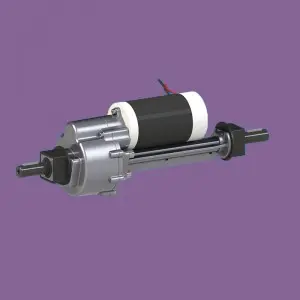In the world of automotive engineering, the term “transaxle” appears frequently in discussions about vehicle design and performance. But what exactly is a transaxle? What types of vehicles use this part? This article will take an in-depth look at the intricacies of transaxles, their functions, and the various types of vehicles that use transaxles.
What is a transaxle?
The transaxle is a key component in many vehicles, combining the functions of the transmission, axle and differential into a single unit. This integration allows for a more compact design, which reduces weight and improves handling characteristics. Transaxles are typically used in front-wheel drive vehicles, but are also available in some rear-wheel drive and all-wheel drive configurations.
Transaxle components
- Gearbox: The gearbox is responsible for changing the transmission ratio so that the vehicle can accelerate and decelerate efficiently. In a transaxle, the transmission is usually automatic or manual, depending on the vehicle’s design.
- Differential: A differential allows the wheels to rotate at different speeds, which is especially important when cornering. Without a differential, the wheels would be forced to spin at the same speed, causing tire wear and handling issues.
- Axle: The axle transfers power from the engine to the wheels. In a transaxle, the axle is integrated into the same housing as the transmission and differential, which helps save space and reduce weight.
Transaxle function
The primary function of the transaxle is to transfer power from the engine to the wheels while enabling smooth shifting and efficient handling. In front-wheel drive vehicles, the transaxle is usually located at the front of the vehicle and is connected directly to the engine. This configuration allows for a more compact design, resulting in improved fuel efficiency and handling.
In addition to power transmission, the transaxle also plays a role in vehicle stability and control. By placing the weight of the transaxle over the front wheels, manufacturers can increase traction and improve handling characteristics, especially in adverse weather conditions.
Vehicle types using transaxles
1. Front-wheel drive vehicles
The most common application of transaxles is in front-wheel drive (FWD) vehicles. In these vehicles, the engine is mounted transversely (sideways) and the transaxle is located directly below the engine. This design allows for a more compact layout, resulting in greater fuel efficiency and improved handling. Examples of front-wheel drive vehicles using a transaxle include:
- Compact Cars: Models such as the Honda Civic and Toyota Corolla are often equipped with transaxles to achieve a balance of performance and fuel efficiency.
- Sedans: Many midsize sedans, such as the Ford Fusion and Nissan Altima, also use transaxles in their front-wheel drive configurations.
2. Sports car
Some sports cars utilize transaxles to achieve balanced weight distribution and improved handling. In these vehicles, the transaxle is usually located in the rear, allowing for nearly 50/50 weight distribution. This configuration enhances cornering performance and stability. Notable examples include:
- Porsche 911: This iconic sports car uses a rear-mounted transaxle, which contributes to its legendary handling characteristics.
- Alfa Romeo Giulia: This high-performance sedan uses a transaxle to optimize weight distribution and enhance driving dynamics.
3. SUVs and Crossovers
While many SUVs and crossovers use traditional drivetrains, some models employ transaxles, especially those with front-wheel drive configurations. This design helps improve fuel efficiency and handling. Examples include:
- Honda CR-V: This popular compact SUV features a transaxle in its front-wheel-drive model, balancing performance with practicality.
- TOYOTA RAV4: Like the CR-V, the RAV4 uses a transaxle in its FWD models, improving fuel efficiency and driving dynamics.
4. Electric vehicles
As the automotive industry transitions to electrification, many electric vehicles (EVs) are adopting transaxle designs. The compactness of the transaxle makes it ideally suited for electric drivetrains, where saving space and weight is crucial. Examples include:
- Tesla Model 3: This electric sedan’s transaxle integrates the electric motor, transmission and differential to optimize performance and efficiency.
- Nissan Leaf: The Leaf features a transaxle design that efficiently transfers power from the electric motor to the wheels.
5. Karts and ATVs
Transaxles are not limited to passenger cars; they are also commonly found in go-karts and all-terrain vehicles (ATVs). In these applications, the transaxle’s compact design and integrated components provide the power transfer and handling characteristics required for off-road performance. Examples include:
- GO KARTS: Many recreational go karts utilize a transaxle to provide smooth acceleration and handling on a variety of terrains.
- All-Terrain Vehicles: All-terrain vehicles are often equipped with a transaxle to meet the needs of off-road driving, providing power to the wheels while allowing differential action.
Advantages of using a transaxle
- Space Efficiency: By combining multiple components into a single unit, the transaxle saves space in the vehicle design, allowing for more efficient use of interior space.
- Weight Savings: Integrating the transmission, differential and axles into a single unit reduces weight, thereby improving fuel efficiency and handling.
- Improved Handling: Transaxle placement enhances weight distribution for better traction and stability, especially in front-wheel drive vehicles.
- Simplified Design: Using a transaxle simplifies the overall design of the vehicle, making it easier to manufacture and maintain.
in conclusion
Transaxles play a critical role in the design and performance of all types of vehicles, from compact cars to high-performance sports cars and electric vehicles. They combine multiple functions into a single unit, saving space and weight, improving handling and increasing fuel efficiency. As the automotive industry continues to evolve, transaxles will continue to be an important part of modern vehicles’ pursuit of better performance and efficiency. Whether you drive a family sedan, a sport coupe, or an electric vehicle, understanding the role of a transaxle can deepen your appreciation of today’s automotive engineering.
Post time: Sep-27-2024


